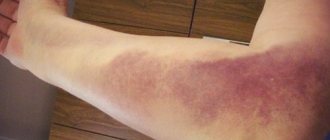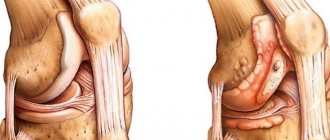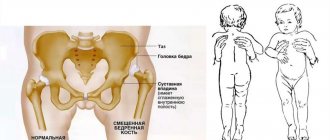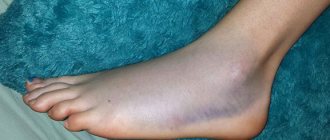Swelling of the legs is an extremely common problem, which often signals the presence of serious pathologies in the body. But it is not uncommon for healthy people to have swollen legs due to minor problems. We strongly recommend that you consult a specialist if your legs are swollen in order to exclude or confirm the presence of diseases.
Both men and women can experience swelling of the legs at any age. Most often, discomfort and visual changes begin to appear in the late afternoon. But as mentioned earlier, swelling of the foot is not always a signal of the presence of a disease or pathology in the body. Below, you can learn about the most common causes of swollen feet.
- Lifestyle
- Shoes
- Metabolic disease
- Injuries
- Pathologies
Possible reasons
There are various causes and signs of painful leg swelling in the foot or ankle areas. Listing them will benefit even people who do not have swelling of the feet, for the purposes of prevention and prevention.
Small in size or simply uncomfortable shoes.
There are several options in this category. The problem may be that the material from which the shoes are made is too hard, or that the heel is quite high. In both cases, fluid stagnation in the leg or poor circulation may cause discomfort. This is dangerous due to the appearance of painful tumors and edema.
Any type of leg injury.
Frequent causes of swelling and pain in the foot are dislocations, fractures or sprains. If a person twists his leg, he feels aching pain that intensifies when walking. If a fracture occurs, the painful sensations are felt strongly, and the pain increases.
In such cases, self-medication is strictly prohibited. Only the attending physician can prescribe medications and procedures.
Flat feet.
Flat feet are characterized by deformation of the arches of the feet. As a result, the main load goes to the human spine. The reasons for possible inflammation lie in the following fact: in men this decrease in the arch was transverse, but in women it was and is considered longitudinal.
The pain with flat feet is aching, in other, serious cases it is acute. Swelling appears in the area of the foot, and the size of the foot may change.
Diseases of the liver, heart or kidneys.
Swelling and pain in the feet appears due to heart, kidney or liver failure, which causes fluid accumulation in a certain area of the body and circulatory problems. In similar situations, swelling most often appears in the ankle area.
If you have diseases of the liver, heart or kidneys, it is useless to self-medicate the tumor. Only a specialist can give detailed instructions.
Arthrosis and arthritis.
Osteoarthritis and arthritis are considered inflammatory infections. Arthritis first affects the joint. The disease then affects the entire body. Arthritis pain is assessed as acute, which tends to intensify at night.
With arthrosis, pain is felt only while the person is in motion. During other hours it may even disappear completely.
Phlebeurysm.
This disease is characterized by cramps and aching pain. In more serious cases, darkening of the lower leg occurs. The legs in the foot area swell equally in both men and women. As a result of varicose veins, a change in the elasticity of the walls of blood vessels occurs.
This disease most often causes leg swelling in men. This is explained by a more intense daily load, frequent lifting of various heavy things.
Overweight.
Overweight people often face a similar problem. This is due to the strong pressure exerted on the foot during movement or other physical activity. In this case, doctors recommend losing weight and drinking more fluids (preferably clean water).
Pregnancy.
Swelling of the feet in women most often occurs during hormonal changes. This includes both pregnancy and some time after childbirth, as well as the days before menstruation or the menopause.
These phenomena are considered normal and therefore do not require urgent treatment. However, if there is severe pain and swelling in the legs, pregnant women can consult with obstetricians.
Metabolic disease
There are two main causes of swollen feet due to metabolic disorders:
- Obesity. In addition to poor circulation, the load on the legs increases significantly, which leads to swelling in the feet.
- Pregnancy. Pregnant women experience swelling of the legs caused by physiological and pathological reasons. Physiological reasons include increased stress on the legs and hormonal changes. There is a risk of hystosis; this is an extremely unpleasant disease, in the presence of which you need to consult a specialist as soon as possible.
Symptoms
It is not difficult to calculate noticeable swelling of the ankle or swelling of the left or right leg in the area of the foot, located above or below. Most often, the tumor has excellent visibility, and the pain is quite clearly felt. Below are a few prominent symptoms:
Firstly, after any type of injury or inflammatory disease, the foot sometimes changes its usual shape. If a person twists his leg, after which a swelling becomes noticeable, and the foot changes in size, then this is a sure sign that there is a problem.
Also, swelling is clearly visible on the affected leg. With swelling of the feet, it is common for men and women to experience swollen toes.
Skin color often changes. It also happens that the leg first swells in the foot area and some time later becomes reddish or even blue. After a hematoma appears, you should immediately undergo an examination and consult about subsequent treatment.
Foot swelling is also characterized by the fact that it is painful to step on the unhealthy leg during any movement. All steps and movements are characterized by mild to severe pain.
If a person twists his leg, then the pain is felt mainly when there are attempts to take steps or move.
If the foot is slightly swollen on top and has been hurting for a long time, then the swelling and pain subsequently spread to the ankle.
Treatment of edema and tumors of the leg
What should you do if, due to one of the above reasons, tumors become noticeable on your leg? In a situation where the ankle swells quickly or if a person twists, dislocates or breaks his leg right before our eyes, then you should immediately call an ambulance. If the swelling process is quite slow, you can go to the hospital on your own.
To provide quick assistance, you should lay the person on his shoulder blades and put something soft under his sore leg. This action will help cause the outflow of fluids from a certain point.
If the cause of severe or nagging pain in the leg in men or women is a minor injury, then it can be completely cured on your own. In such situations, apply a cold compress to the sore spot or make an iodine mesh on the injured leg. To eliminate swelling, experts advise limiting fluid intake.
The appearance of tumors and edema indicates damage to blood vessels or kidneys. It is tumors that make movement problematic, so they should be eliminated as quickly as possible.
Experts recommend that if you have a tumor in both the left and right leg, you should never prescribe medications to yourself without consulting your doctor.
You should consult a doctor if ankle swelling is a consequence of a chronic disease. These include, for example, heart or kidney failure. These diseases cause fluid stagnation in the body.
It also wouldn’t hurt to get help from a qualified specialist if the tumor is so strong that a child or adult cannot step on their foot. This is usually caused by arthritis, arthrosis or venous insufficiency.
You should immediately consult a doctor if leg tumors in men and women are common. This may serve as a prerequisite for some serious disease, which only a specialist can identify.
You should consult a doctor if, along with the tumor, a person also notices numerous unpleasant symptoms. For example, a change in skin color, high temperature, severe pain in the injured leg.
Treatment of edema
If your foot is swollen and hurts a lot for a long time, and a specialist after tests does not confirm serious violations, then there are several tips for removing the tumor:
- Lying on a horizontal surface, raise your legs above you and hold for about ten minutes.
- It is allowed to take medications that relieve inflammation. These include ibuprofen or aspirin.
- Before going to bed, you should place a pillow under your feet.
- It is recommended to completely avoid shoes with heels. It is allowed to wear special orthopedic shoes.
- Drink plenty of clean water per day.
- Minimize salt intake in food.
- Do not sit or stand in one place for a long time.
- If possible, avoid weight gain or get rid of excess weight.
- Take frequent walks, which tend to stimulate blood circulation.
- A person whose job requires him to sit all day must independently perform some simple gymnastic exercises.
Treatment at home
Epsom salt baths.
Epsom salt is magnesium sulfate, which can both relieve swelling and pain and improve blood circulation. If the ankle is swollen and the foot is swollen during movement, this substance should be dissolved in clean water and lie in such a bath for fifteen or twenty minutes.
Yoga classes.
It is yoga that helps get rid of blood stagnation in the area of the foot and ankle; practicing it improves blood circulation. To begin with, you should slowly bend and straighten your toes, and then begin to stretch your feet.
It is muscle stretching that helps improve blood circulation, which ultimately relieves foot swelling. To do this, you need to lie with your stomach up and lie for twenty minutes with your legs raised up, placed against the wall at an angle of ninety degrees.
Magnesium.
If the foot is quite swollen on top and hurts a lot, and it hurts to step on it while moving, then magnesium supplements will be the best medicine. It is the lack of magnesium in the body that causes fluid accumulation in tissues and painful inflammation.
Often the feet swell at the top, which makes even basic movement in space problematic, and magnesium supplements can eliminate this problem.
Foot massage.
This method of getting rid of foot swelling is most suitable for people who, due to their work, spend all day on their feet. Experts advise using soothing chamomile and cypress oils for massage. This procedure usually starts at the very bottom of the foot and continues upward.
Liquid.
Many people don't drink enough fluids, which causes the body to decide it's time to start storing moisture. This causes ankle swelling. Water is designed to dilute the additives entering the body with food.
Water relieves inflammation and prevents swelling. The norm per day is two liters of water. To reduce the likelihood of inflammation, people also drink lemon water.
Essential oils.
Essential oils are varied. They are most often used for massage, as they reduce the risk of leg inflammation in the upper area of the foot. If your foot hurts very badly, you should use the anti-inflammatory properties of lavender and the cooling properties of eucalyptus and mint.
Swimming.
If your ankle is swollen, swimming in cold or warm water will help relieve the pain. It would be wiser to choose colder water for swimming, since the cool atmosphere stimulates blood circulation, which also helps treat swelling in the leg.
Compression jersey.
Compression hosiery exerts precisely calculated and dosed pressure on the venous walls. Because of it, the blood begins to move much faster, which helps treat tumors and relieve discomfort in the foot.
Bad habits.
It is salt and caffeine that contribute to excess fluid in tissues and the formation of edema and tumors. If the foot is swollen on top and hurts for a long time, then it is better to give up coffee in favor of plain water, and replace regular salt with sea salt.
Exercises.
If the swelling on the bottom of the foot gradually increases, then you can do several exercises to improve blood circulation. To begin with, you can limit yourself to simple exercises, and in the future try to do more complex exercises.
You need to act based on sensations - you can’t do anything through pain, this is a sure way to unpleasant consequences.
Special gymnastics to relieve swelling of the extremities.
If the ankle is very swollen, then the following exercises, developed by specialists, can help relieve swelling at home. Also, these exercises will be useful for prevention purposes.
- Place the heel of your left foot on the floor while simultaneously lifting the toe of your right foot, and vice versa. The exercise is done for five or ten minutes.
- Lie down on a soft horizontal surface near the wall and raise your legs, leaning them against the wall. This gymnastics is necessary for people who are often on the move.
- Walking on tiptoes for five minutes can protect against swelling of the top of the foot.
- To improve blood circulation and stimulate blood circulation in the body, you should clench and unclench your toes for several minutes.
- The easiest exercise is considered to be gripping small objects on the floor with your toes. For such purposes, it is better not to use things that can cause injury: for example, injure.
- You can stretch your feet by rotating them left and right. It also has a positive effect on blood circulation.
- A simple exercise such as jumping on your toes will help prevent foot swelling.
- You can bend your toes as you please.
Pathologies
First of all, it is worth examining the kidneys - they are the ones that most often provoke edema. If, due to illness, they are unable to cope with the large amount of fluid they consume, it will inevitably be retained in the limbs.
- Problems of the cardiovascular system. Due to the fact that the heart cannot cope with the load, the veins become clogged and blood can accumulate in the lower extremities;
- Destruction of the joints in the feet (rheumatism). Swelling begins to form around damaged hard tissues due to the accumulation of fluids and excess blood;
- Varicose veins Due to insufficient performance of the veins, fluid stagnates in the lower extremities. This usually happens in the late afternoon, but in the morning everything goes away.
- Liver diseases and hormonal disorders lead to improper metabolism, in which the body begins to absorb fluids worse.
Prevention
How to treat a foot tumor on the top or bottom of a person who only periodically suffers from these ailments? Some preventive measures will come to his aid that can get rid of swelling in the future.
- You should move more, go for walks and sometimes go to the gym. An active lifestyle helps improve blood circulation, strengthens muscles and prevents fluids from remaining in certain places for a long time.
- You should not buy beautiful, but comfortable shoes. Because of this, the foot will be healthier and the shoes will be much more practical.
- People who work in sedentary jobs should definitely do simple short exercises to prevent their legs from getting sore and swollen in the future. They will help improve blood circulation and the outflow of fluids from the tissue.
- The best preventative remedy is a foot massage. You can do it yourself every week or every day. The main thing is to start from the bottom and smoothly move up.
- To relax, you can spend your days off taking baths with the supplements described above.
- After a long walk or workout, it’s a good idea to hold your tired legs upright for a while.
- Reduce salt intake to a minimum, and if possible, completely eliminate it from your daily diet.
- If a person suffers from varicose veins, it is recommended to wear special compression garments.
- Minimize alcohol consumption.
Tags: arthritis, arthrosis, pregnancy, varicose veins, excess weight, shoes, flat feet, injury About the author: Andrey Stepanovich
« Previous entry
Lifestyle
It is quite easy to identify these causes of swollen feet; you just need to change your lifestyle a little and give up some habits:
- Excess fluid in the body. Due to excessive consumption of water during the day, it overflows the vessels and enters the soft tissues, lingering there.
- Incorrect placement of legs in a sitting position. Most often we are talking about when you sit cross-legged. Because of this, blood flow in the lower leg is disrupted and the veins are compressed. As a result, the leg swells;
- Standing for a long time. First of all, this applies to those who spend the entire working day on their feet. Due to excessive stress, swelling of the legs is quite common;
- Inconvenient workplace. Unlike the reason above, here we are talking about a sedentary pastime. Stools that are too soft or low have a negative effect on blood circulation in general;
- Excessive physical activity. You can include active walking, running, strength exercises and stretching. If you do these activities uncontrolled and too much, your feet can become swollen very easily.











